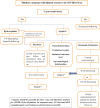Pituitary adenoma surgeries in COVID-19 era: Early local experience from Egypt
- PMID: 33194296
- PMCID: PMC7655998
- DOI: 10.25259/SNI_472_2020
Pituitary adenoma surgeries in COVID-19 era: Early local experience from Egypt
Abstract
Background: The pandemic of COVID-19 has a great impact on all health-care services worldwide. Neurosurgical recommendations are to postpone the endoscopic endonasal pituitary surgeries during the pandemic. We would like to express our experience with urgent pituitary adenomas during the current COVID-19 pandemic.
Methods: In our country, COVID-19 has started to become a paramount problem by March 2020. Nine cases of pituitary adenomas have presented with urgent manifestations. The endoscopic endonasal approach was performed in eight patients, while a craniotomy was selected for a recurrent pituitary adenoma. Pre- and postoperative thorough clinical evaluations with chest CT scans were performed. Other strict infection control measures have been applied.
Results: In 8 weeks duration starting from the past days of February 2020, we have operated on four females and five males of pituitary adenomas. Visual deterioration was the main presenting symptom. The driving factor for surgery was saving vision in eight patients. Fortunately, the postoperative course was uneventful for all patients. No suspected COVID-19 infection has been reported in any patient or health-care team except one patient. In our city, PCR test was routinely not available.
Conclusion: In the era of COVID-19, strict infection control precautions should be employed to limit the possibility of transmission of any possible infection to patient or any of the surgical team. We believe that the risk of getting such infection is not increased by the endonasal approach. Long-term follow-up and large numbers of prospective studies are recommended to delineate the impact of COVID-19 infection on pituitary surgeries.
Keywords: COVID-19; Craniotomy; Endonasal; Endoscopic; Pituitary.
Copyright: © 2020 Surgical Neurology International.
Conflict of interest statement
There are no conflicts of interest.
Figures




References
-
- Arnaout MM, Gerges MM, Cummock MD, El Asri AC, Greenfield JP, Anand VK, et al. Endonasal surgery for suprasellar germ cell tumors: Two cases and review of the literature. Acta Neurochir (Wien) 2019;161:1699–704. - PubMed
-
- COVID-19 Diagnosis and Treatment-Egyptian Protocol-ECMO Experts. Available from: https://www.ecmoexperts.com/covid-19-resources-egyptian-diagnosis-treatment [Last accessed on 2020 Jul 21]
LinkOut - more resources
Full Text Sources
Miscellaneous
